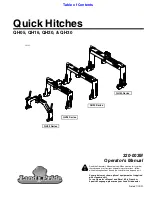
6 - WORKING OPERATIONS
Ballasting the tractor
For sufficient traction and maximum performance in heavy draft operations and to counterbalance rear-mounted equip-
ment weight should be added to the tractor in the form of cast iron weights or rear mounted ballast box. Only enough
weight should be added to provide good traction and stability. Adding more weight than is needed results in unnec-
essary soil compaction increased rolling resistance and higher fuel consumption.
NOTE:
When adding weight to the tractor tire pressures may need to be increased. See
7-24
in this manual.
Front end ballast may be required for stability and steering control when weight is transferred from the front wheels
to the rear wheels as an implement is raised by the tractor three-point hitch.
Use the following as a general guide:
• Ballast the tractor (less implement) so that approximately one-third of the tractor weight is on the front wheels. For
optimum traction tractors equipped with 4WD should be ballasted so that
40 – 45%
of machine weight is on the
front wheels.
• When a rear mounted implement is raised to the transport position the front wheel reaction should be at least
20%
of tractor weight.
• Add additional front end ballast as required for stability during operation and transport. Tractor front end ballast may
not always maintain satisfactory stability if the tractor is operated at high speed on rough terrain. Reduce tractor
speed and exercise caution under these conditions.
• When using front-mounted equipment add weight to the rear axle to maintain good traction and stability. Front-
mounted equipment varies in weight. Refer to equipment manual for ballasting.
Weighting limitations
The weighting limitations that follow are limitations only. They do not imply that the tractor should be weighted to attain
the weights given. Use only enough weight to obtain good performance.
Technically maximum permissible mass
The table below is the maximum permissible mass for the tractor and it includes all implements and ballast weight.
Do not exceed these mass ratings.
Technically maximum permissible mass
Mass
Front axle
650 kg
(
1433 lb
)
Rear axle
840 kg
(
1852 lb
)
Combined front and rear axle
1200 kg
(
2646 lb
)
Tire load capacity
The table below is the load capacity of the tires. Do not over the load the tires. The axle rating of the tractor may be
less than the capacity of the tires. Do not exceed the maximum permissible mass of the tractor.
Tire position
Tire size
Tire type
Load capacity
Front
18x8.50-10
R3 (Turf) 4 ply
375 kg
(
827 lb
)
Front
18x8.50-10
R4 (Industrial) 4 ply
375 kg
(
827 lb
)
Rear
26x12.0-12
R3 (Turf) 4 ply
807 kg
(
1779 lb
)
Rear
26x12.0-12
R4 (Industrial) 4 ply
810 kg
(
1786 lb
)
6-5
Содержание Workmaster 25S
Страница 20: ...1 GENERAL INFORMATION 1 14 ...
Страница 102: ...3 CONTROLS AND INSTRUMENTS 3 40 ...
Страница 118: ...4 OPERATING INSTRUCTIONS 4 16 ...
Страница 186: ...7 MAINTENANCE 7 50 ...
Страница 199: ...9 SPECIFICATIONS NHIL17CT01125FA 1 NHIL17CT01124FA 2 9 9 ...
Страница 200: ...9 SPECIFICATIONS 9 10 ...













































